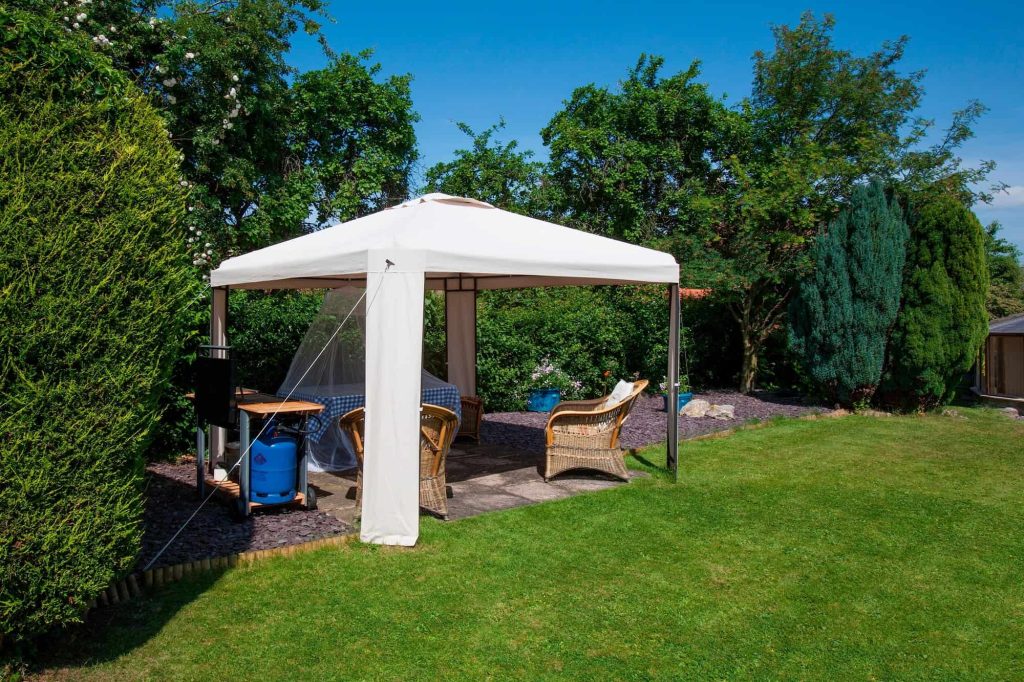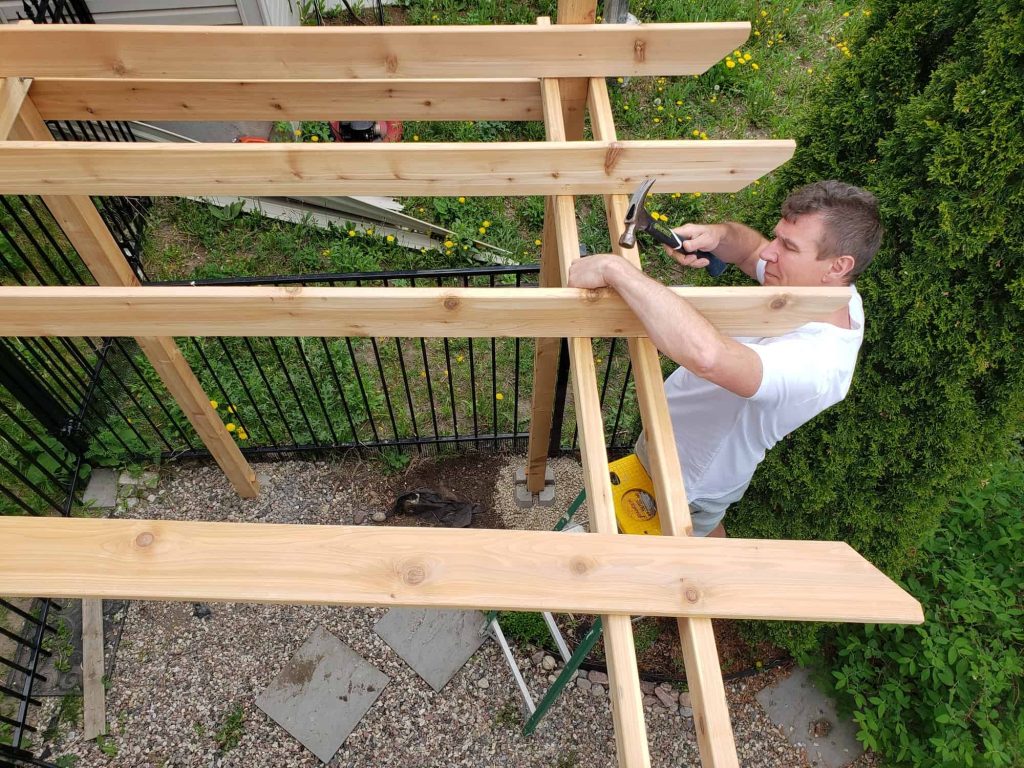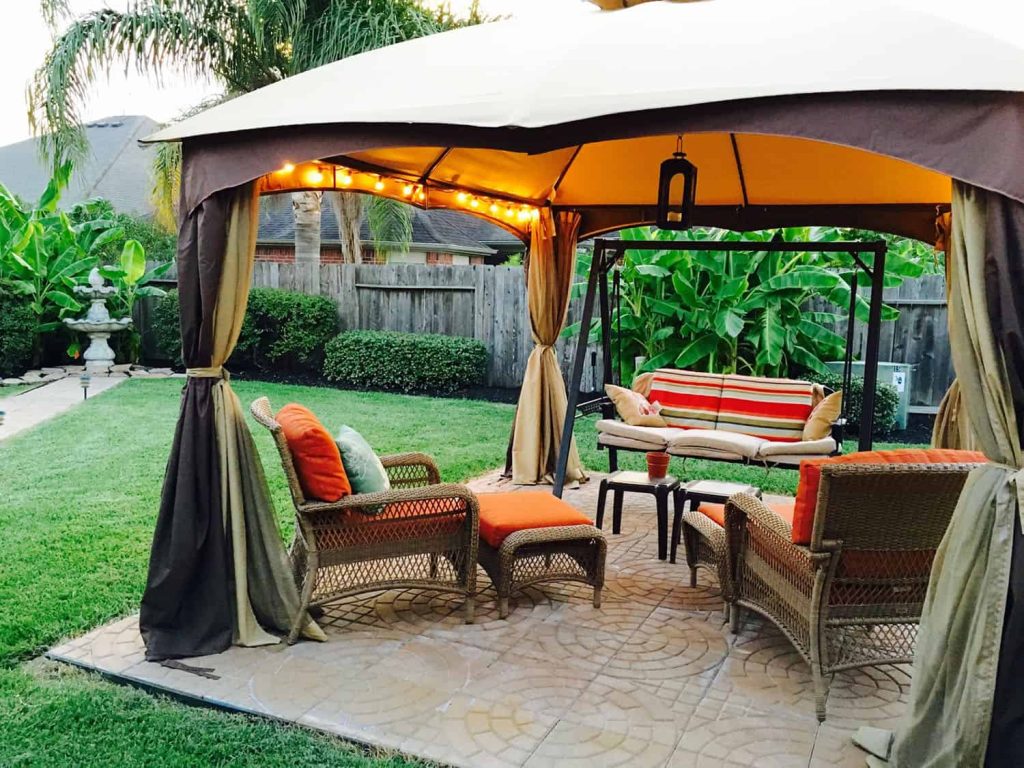Weather forecasts that predict windstorms or rainfall may be bad news for Gazebo owners. Gazebos can be built or erected to be either temporary or permanent structures. The temporary structures are prone to be damaged faster than the permanent structures.
The fear of Gazebo owners lies in if the structural integrity would be preserved against extreme weather conditions. Constant exposure of the Gazebo to rain, snow, mildew, and wind can reduce the durability of the structure. If caution is not taken in some cases, Gazebos can be destroyed by just one windstorm.
This worry has caused most owners to be skeptical about leaving their Gazebo outdoors.
What kind of Gazebo can be left outdoors? How can you protect your Gazebo from wind and moisture build-up? We have provided answers to these questions and have offered tips for maintaining your Gazebo whether it is a temporary or permanent structure. In addition, we included common mistakes Gazebo owners make before, during, and after erecting their Gazebo.
Can I leave a Gazebo up overnight?
Yes, you can leave your Gazebo overnight. However, this depends on the material used in constructing the Gazebo. A gazebo can be constructed with wood, vinyl, fabric, metal, and even fiberglass.
Leaving a Gazebo overnight implies you are exposing it to weather elements overnight. The weather elements could be wind, snow, rain, or dew droplets.
Constant exposure to these damaging conditions reduces the durability of your Gazebo; this implies that if you expose your Gazebo to constant wind, rain, snow, or dew droplets, you are adversely reducing the lifespan of your Gazebo.
The major threat to a Gazebos structural integrity is moisture build-up and winds. Moisture build-up and winds are the major destructive elements of your Gazebo. Moisture build-up can lead to rot or rust; rot for wood and rust for metal.
How can I protect my Gazebo from moisture?

Gazebo roofs that are made with fabric are more prone to moisture damage than other materials because the toughness level of the materials varies. There are ways you can reduce the moisture from affecting your Gazebo.
- One way to preserve the fabric from moisture is to make use of a water repellant spray at least once a year to make the fabric water-resistant.
- When installing or erecting the Gazebo, ensure the location is void of trees and heavy vegetation.
- Cover the Gazebo with a tarpaulin. Tarpaulins are waterproof materials used to resist water and mildew growth.
- Fiberglass roofs are water-resistant and are an effective measure against moisture build-up.
- For wooden Gazebo, make use of water-resistant wood such as teak, redwood, and bald cypress.
How can I protect my Gazebo from wind?
For wind-related issues, a Gazebo’s resistance to wind depends on the surface the Gazebo is built on, the material, and the quality of the material used. If the weather forecast predicts a windy night, there are ways you can secure the Gazebo if it would be left outdoors overnight.
- The most sturdy surface or foundation for Gazebo is concrete.
- Make use of Gazebo leg weights- The weights keep the Gazebo structure affixed to the ground. Sandbags also come in handy to protect your Gazebo from windstorms.
- Anchor kits are one of the most secure methods of safeguarding your Gazebo.
- Gazebo pegs help secure structures. Through the pegs, you can pass strong ropes and cords to fasten the structure to the ground
- Strong polythene straps which are also called ratchet tie-down straps have high breaking points which guarantee that your Gazebo is guarded during a windy day
- The popular saying “there’s strength in numbers” applies to saving your Gazebo. Gazebos have more threshold to the wind when they are anchored to other Gazebos.
Tips for maintaining your Gazebo
Some Gazebos last longer than others and this is due to the maintenance behavior of their owners. We have provided a list of ways your Gazebo can be maintained.
- Prevent moisture build-up from snow or water- Regularly check for mildew and mold and gently scrub them off.
- Apply protective layers to the Gazebo- Spray, seal, or paint the beams and poles to prevent rot and rust.
- For wooden Gazebos, consistently check for pest infestation. Early detection can save your Gazebo
- Consistently check for tears and holes in the roof
- To support the Gazebo, make use of only Gazebo frames
- Clean the Gazebo regularly with all-purpose cleaning agents
- Annually refurbish the Gazebo
Common mistakes Gazebo owners make
Erecting a Gazebo means you must have an ample amount of knowledge about Gazebos. Some of these mistakes are due to either ignorance or negligence; they include:
1. Improper placement
When Gazebos are wrongly placed, the structure is prone to damage. Before building or buying your Gazebo, ensure you have made proper research on the location where the Gazebo would be situated. This gives you an idea of the best location for a Gazebo and which must be void of wires, pipes, and damaging elements like trees.
2. Incorrect measurements or installation

Whether you chose to erect or install your Gazebo, ensure you comply with installation guidelines and instructions. To single-handedly build the Gazebo means you must work with an accurate plan that reflects accurate measurements. If you discover any hurdle, do well to seek professional help.
An indication that your Gazebo is not properly shaped is it would give off a wobbly and irregular shape. Ensure all screws and bolts are properly affixed to the structure. Loosened screws make the Gazebo prone to wind damage
3. Leaving temporary Gazebos overnight
During extreme weather conditions like winter, it is advisable to disassemble the Gazebo to prevent a snow build that could weaken the integrity of the Gazebo if there are no protective kits to safeguard them. For permanent structures, consider installing a heating system during winter.
4. Inappropriate storage
For Gazebo kits, ensure they are protected from moisture build-up when storing them.
5. Refusal to consistently check for damages
This is common mistake Gazebo owners make. Gazebos must be consistently checked for damages or structural deformity. This helps prevent mishaps.
6. Purchasing the wrong materials
The material used in constructing a Gazebo is an essential aspect that must not be ignored. Before building or buying a Gazebo, make a survey concerning where quality materials could be purchased. When poor-quality materials are used, they tell on the structure later.
Do not substitute good quality for lesser quality because of cost implications.
Failure to get a permit gets you on the wrong side of the law is also another issue.
Leaving Your Gazebo Overnight FAQs
Here are some of your questions answered.
How long can you leave a Gazebo for?
Can you leave a Gazebo out?
Can you sleep in a Gazebo?
Final Thoughts
Keeping your Gazebo outdoors may not be a terrible idea. To get the best out of your Gazebo in terms of its durability, make use of protective elements that can safeguard your Gazebo against moisture and wind damage. In addition, consider using concrete to get a sturdy structure.
Read more:
